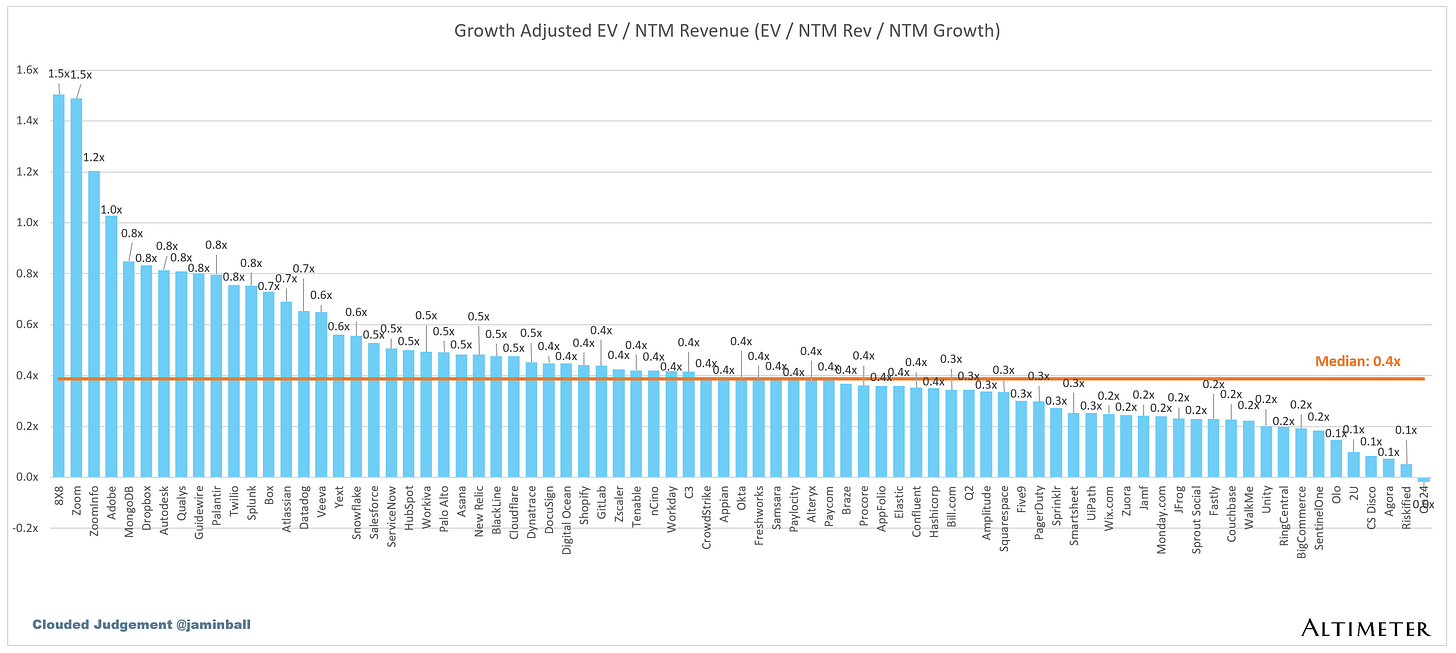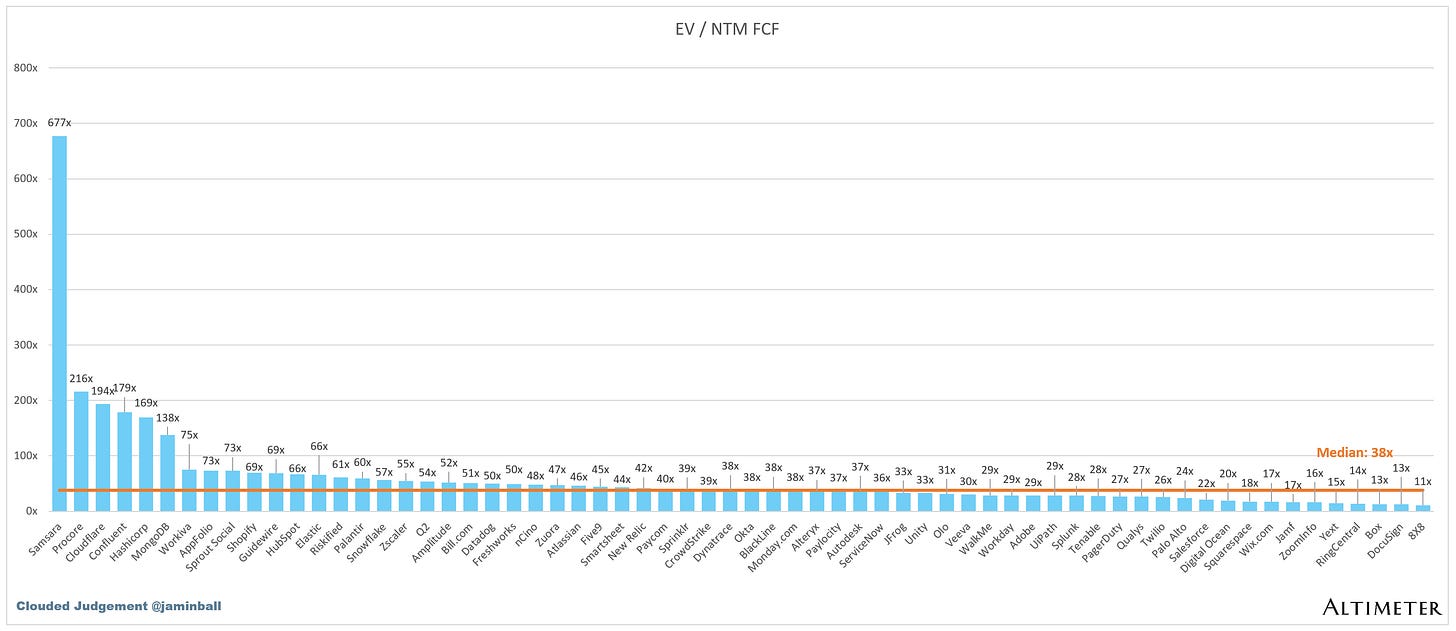Every week I’ll provide updates on the latest trends in cloud software companies. Follow along to stay up to date!
10Y Keeps Climbing
The 10Y hit 5% this week, which sets a new high water mark. In general economic data has continued to come in strong (a data point suggesting inflation could stay sticky, and the economy can absorb rates staying higher for longer). For context on a 10Y at 5% - from 2010 to 2020 the 10Y averaged roughly ~2.5%. Said another way, the 10Y today is double what it averaged from 2010 to 2020.
Hyperscaler Preview
Next week Amazon, Microsoft and Google report earnings and we’ll see Q3 data for AWS, Azure and Google Cloud. These are thought to be the early AI winners, largely due to all of the compute they’re selling to power GenAI applications. However, it’s important to keep in mind that while hype and expectations are quite high around AI, true enterprise buying cycles typically lag. Office 365 Copilot, for example, doesn’t go live until November and we most likely won’t see meaningful revenue from it until next year. And while we’re definitely in the early stages on an important technology transformation and supercycle, headwinds around cloud optimizations might not have abated as much as anticipated by now.
Azure: Grew 27% last quarter, and consensus expectations are for 26-27% growth this quarter
AWS grew 12% last quarter, and consensus expectations are for 12-13% growth this quarter
Google Cloud grew 28% last quarter, and consensus expectations are for 26% growth this quarter.
As you can see, expectations are for growth to stop decelerating this quarter. You can see the last few years of quarterly growth in the charts below:
Top 10 EV / NTM Revenue Multiples
Top 10 Weekly Share Price Movement
Update on Multiples
SaaS businesses are generally valued on a multiple of their revenue - in most cases the projected revenue for the next 12 months. Revenue multiples are a shorthand valuation framework. Given most software companies are not profitable, or not generating meaningful FCF, it’s the only metric to compare the entire industry against. Even a DCF is riddled with long term assumptions. The promise of SaaS is that growth in the early years leads to profits in the mature years. Multiples shown below are calculated by taking the Enterprise Value (market cap + debt - cash) / NTM revenue.
Overall Stats:
Overall Median: 5.7x
Top 5 Median: 14.3x
10Y: 5.0%
Bucketed by Growth. In the buckets below I consider high growth >30% projected NTM growth, mid growth 15%-30% and low growth <15%
High Growth Median: 11.8x
Mid Growth Median: 8.2x
Low Growth Median: 3.6x
EV / NTM Rev / NTM Growth
The below chart shows the EV / NTM revenue multiple divided by NTM consensus growth expectations. So a company trading at 20x NTM revenue that is projected to grow 100% would be trading at 0.2x. The goal of this graph is to show how relatively cheap / expensive each stock is relative to their growth expectations
EV / NTM FCF
The line chart shows the median of all companies with a FCF multiple >0x and <100x. I created this subset to show companies where FCF is a relevant valuation metric.
Companies with negative NTM FCF are not listed on the chart
Scatter Plot of EV / NTM Rev Multiple vs NTM Rev Growth
How correlated is growth to valuation multiple?
Operating Metrics
Median NTM growth rate: 15%
Median LTM growth rate: 21%
Median Gross Margin: 75%
Median Operating Margin (17%)
Median FCF Margin: 7%
Median Net Retention: 114%
Median CAC Payback: 35 months
Median S&M % Revenue: 42%
Median R&D % Revenue: 27%
Median G&A % Revenue: 16%
Comps Output
Rule of 40 shows rev growth + FCF margin (both LTM and NTM for growth + margins). FCF calculated as Cash Flow from Operations - Capital Expenditures
GM Adjusted Payback is calculated as: (Previous Q S&M) / (Net New ARR in Q x Gross Margin) x 12 . It shows the number of months it takes for a SaaS business to payback their fully burdened CAC on a gross profit basis. Most public companies don’t report net new ARR, so I’m taking an implied ARR metric (quarterly subscription revenue x 4). Net new ARR is simply the ARR of the current quarter, minus the ARR of the previous quarter. Companies that do not disclose subscription rev have been left out of the analysis and are listed as NA.
Sources used in this post include Bloomberg, Pitchbook and company filings
The information presented in this newsletter is the opinion of the author and does not necessarily reflect the view of any other person or entity, including Altimeter Capital Management, LP ("Altimeter"). The information provided is believed to be from reliable sources but no liability is accepted for any inaccuracies. This is for information purposes and should not be construed as an investment recommendation. Past performance is no guarantee of future performance. Altimeter is an investment adviser registered with the U.S. Securities and Exchange Commission. Registration does not imply a certain level of skill or training.
This post and the information presented are intended for informational purposes only. The views expressed herein are the author’s alone and do not constitute an offer to sell, or a recommendation to purchase, or a solicitation of an offer to buy, any security, nor a recommendation for any investment product or service. While certain information contained herein has been obtained from sources believed to be reliable, neither the author nor any of his employers or their affiliates have independently verified this information, and its accuracy and completeness cannot be guaranteed. Accordingly, no representation or warranty, express or implied, is made as to, and no reliance should be placed on, the fairness, accuracy, timeliness or completeness of this information. The author and all employers and their affiliated persons assume no liability for this information and no obligation to update the information or analysis contained herein in the future.


















Hi Jamin, thank you for the weekly articles. End of each week, I look forward reading your articles and l learn a lot. I have been wondering if NTM FCF multiple vs NTM Rev Growth would be something you would be interested to capture in your plots. I understand that some of the companies followed here don’t have positive FCF yet and me up the correlation analysis , but thought it could give another level of depth on how the companies are currently valued by the market. Thanks again!